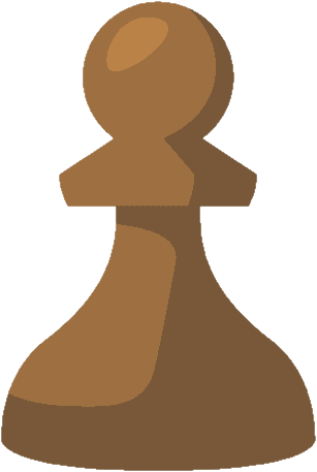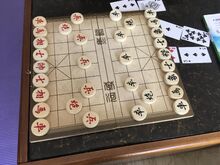
The board, and all pieces in their positions.
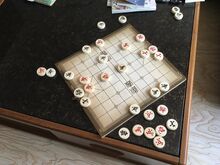
An example of checkmate in Chinese chess. The black general is in check by the red chariot and cannon; the general cannot capture the chariot as it is defended by another chariot, nor can it move to the left as it would then be threatened by another chariot.
Chinese chess (Chinese: 象棋), also known as Xiangqi, is a popular board game currently played by millions of people in many Asian countries. It is not different from chess in principle. Each side has an army, moves one piece per turn, and captures by moving onto an opponent's piece. Differences include a slightly larger board (9 by 10 points), different appearances of pieces (all of them are flat and round, with their types labeled or carved on them), and piece powers changing depending on the location on the board. Owing to China's unique history, geography and cultural background, Chinese chess has its own characteristics. By playing Chinese chess, one can realize the great wisdom of ancient China.
The Game is based on the clash of Liu Bang (刘邦) and Xiang Yu (项羽), two warlords of 汉 (hàn) and 楚(chǔ) that fought for dominance as the Qin Dynasty collapsed into chaos. This is why the same type of pieces have different characters on them, as the two armies had different kinds of troops in them.
The Board[]
The Chinese chess board is a grid of 9 by 10 points (a point is an intersection of any two lines). Unlike in chess, pieces are placed on the points instead of the squares. In the middle of the board, there is a "river", which divides the two sides and affects the movement of some pieces. Each side has a "palace" of 3 by 3 points, marked by diagonal lines on the board. The General and his Guards are not allowed to leave the palace.
The river is formally called "楚河汉界" in Chinese, which means "The border of Chu and Han".
Pieces[]
There are seven types of pieces in Chinese Chess.
Soldiers or pawns (Chinese: 卒/兵): This piece is similar to the pawn in chess. A soldier is allowed to move and capture one point forward before crossing the river, and gains the additional ability to move and capture one point sideways after crossing the river. Unlike the pawn in chess, a soldier is not allowed to advance two points on its first move (hence there is no en passant), and does not promote to another piece upon reaching the farthest rank. A soldier is worth 1 point before crossing the river, and 2 points after crossing the river.
Cannons (Chinese: 炮/砲): Unique to Chinese chess, this piece moves like a rook when not capturing. To capture, however, it has to jump over exactly one piece of either color (known as the "screen"). A cannon is worth 4.5 points.
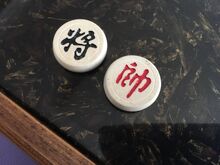
The generals
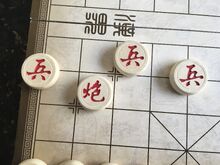
The stations for cannons and soldiers.
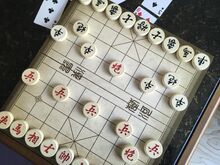
A cannon in this position is fatal because the opponent cannot move any piece in front of the cannon (which would put their own general in check).
Horses or knights (Chinese: 馬/马): This piece is similar to the knight in chess. A horse moves in an "L" pattern: one point orthogonally, then one point diagonally outward. This movement is commonly described as being like the character "日". Unlike the knight in chess, a horse is not allowed to jump over pieces; more specifically, a piece standing next to a horse orthogonally prevents the horse from moving in that direction. Horses begin the game next to the chariots. A horse is worth 4 points.
In Chinese chess sets, the traditional character "馬" is more commonly used than the simplified version, "马".
Chariots or rooks (Chinese: 車/车): This piece is the same as the rook in chess, except there is no castling. Chariots begin the game on the corners of the board. A chariot is worth 9 points.
The Chinese character for this piece, which is commonly pronounced chē (meaning "car"), is pronounced jū in the context of Chinese chess.
Together, the chariots, horses and cannons are referred to as "major pieces" (Chinese: 大子). In fact, one can usually estimate which side has the advantage by comparing the players' major pieces.
Guards or advisors, mandarins (Chinese: 士/仕): This piece has no counterpart in chess. A guard moves one point diagonally within the palace. Guards begin the game on both sides of the general. Guards are pretty important as they help to defend the general. A guard is worth 2 points.
Elephants or ministers, bishops (Chinese: 象/相): This piece moves two points diagonally and is not allowed to cross the river, making it a purely defensive piece. Elephants are not allowed to jump over intervening pieces. Elephants begin the game next to the guards. An elephant is worth 2 points.
General or king (Chinese: 帅/将): This piece is the Chinese chess counterpart of the chess king. It moves one point orthogonally but may not leave the palace. Also, the generals may not stand on the same file without any pieces in between. If a player's general is checkmated or stalemated, they lose the game. There is no castling in Chinese chess.
Rules[]
The basic rules are similar to those of chess; however, there are a few differences.
- Unlike in chess, threefold repetition is not always a draw. If the repetition occurs as a result of one player perpetually checking the enemy general or attacking an enemy piece, that player must make a different move before the same position arises for the third time on the board. If the player fails to do so, they will lose the game.
- Similar to the 50-move rule in chess, Chinese chess has a "60-move rule", which states that a game is drawn as soon as the last 60 moves have been made by each player without any pieces being captured.
- In formal games, the touch-move rule works as in chess. However, players may incur a "violation" (Chinese: 违例) by touching a piece that does not have a legal move.
- In some tournaments, making an illegal move will result in the player losing immediately.
Trivia[]
- As stated before, the same kinds of pieces have different names, even though they function the same and are even pronounced the same.
- The similarities between Chinese Chess and western Chess are due to both of them originating from the Indian game Chaturanga.
External links[]
- Xiangqi on Wikipedia
Adapted from Wikiindex where the relevant page has been deleted because it appears the author is a spammer.
